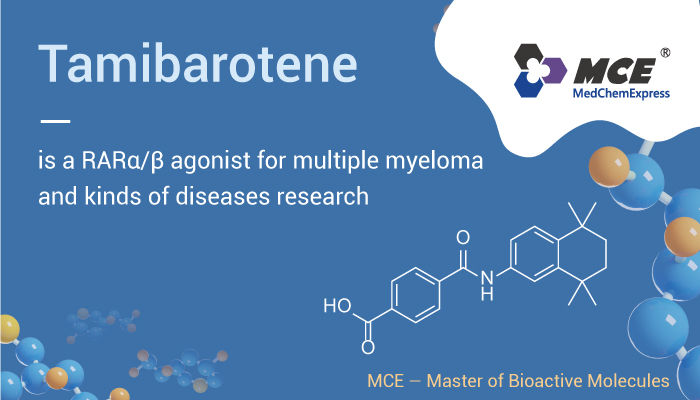RARα is a member of the retinoic acid receptor (RAR) family of nuclear hormone receptors. As reported, RARα usually heterodimerizes with RXRs to inhibit its target gene transcription in the absence of retinoid agonists. But when binding to RARα agonists, the conformation changes. At the same time, the RARα can dissociate from its corepressors, allowing for transcription of differentiation genes. Acute myeloid leukemia (AML) is a biologically heterogenous diseases. A superenhancer (SE) at the retinoic acid receptor alpha (RARα) gene is associated with RARα mRNA overexpression in AML. Therefore, RARα is a useful target for AML treatment. Moreover, Tamibarotene, a synthetic oral retinoid, is an orally active and selective RARα agonist. More importantly, Tamibarotene shows antitumor activity in RARA-high but not RARA-low AML patient-derived xenograft models.
Tamibarotene, a selective RARα agonist, can be used for AML and other cancers research.
In vitro, Tamibarotene (100 nM, 24-72 h) dose-dependently inhibits cell viability of RARα SE+ pediatric AML (pAML) cells and patient samples. Besides, Tamibarotene has no obvious cytotoxicity in the RARA SE− cell line Kasumi1 or in the SE− patient samples. In addition, Tamibarotene (100 nM, 72 h) increases CD38, differentiation markers (CD66 and CD11c) in RARα SE+ pAML cells. Furthermore, Tamibarotene (0-20 μM, 72 h) induces G1-arrest and inhibits RARA and CDK4/6 expression T-cell lymphoma cells.
In vivo, Tamibarotene (6 mg/kg, daily by oral gavage) decreases leukemia disease burden in a RARα SE+ pAML patient-derived xenograft (PDX) mice model. Simultaneously, Tamibarotene prolongs mice survival and increases CD38+ cells percentage, indicating its superior antileukemic efficacy. Apart from AML model, Tamibarotene (10 mg/kg/day, p.o., 6 days) also inhibits VEGF-induced neovascularization in the mouse cornea. In conclusion, Tamibarotene is a selective and orally active RARα agonist, and can be used for AML and other cancers research.
References:
[1] de Botton S, et al. Blood Adv. 2023 May 9;7(9):1858-1870.
[2] Perez MW, et al. Blood Adv. 2021 Dec 14;5(23):4864-4876.
[3] Wang X, et al. Oncotarget. 2017 Apr 18;8(16):26245-26255.
